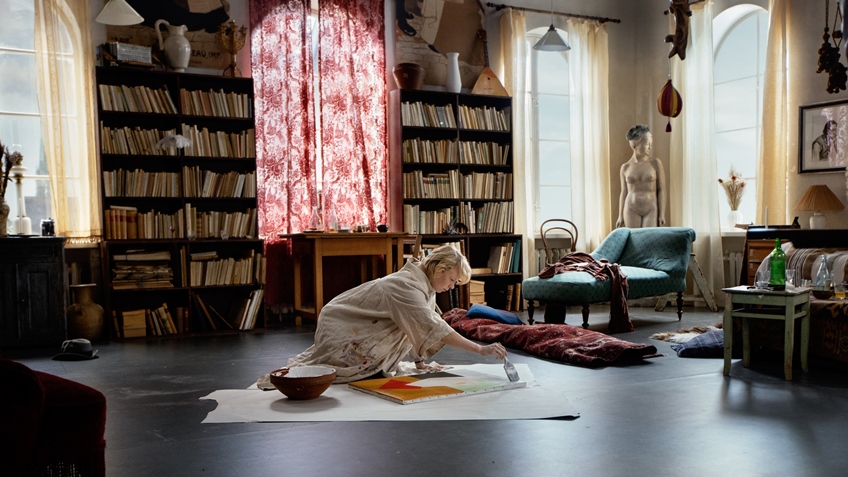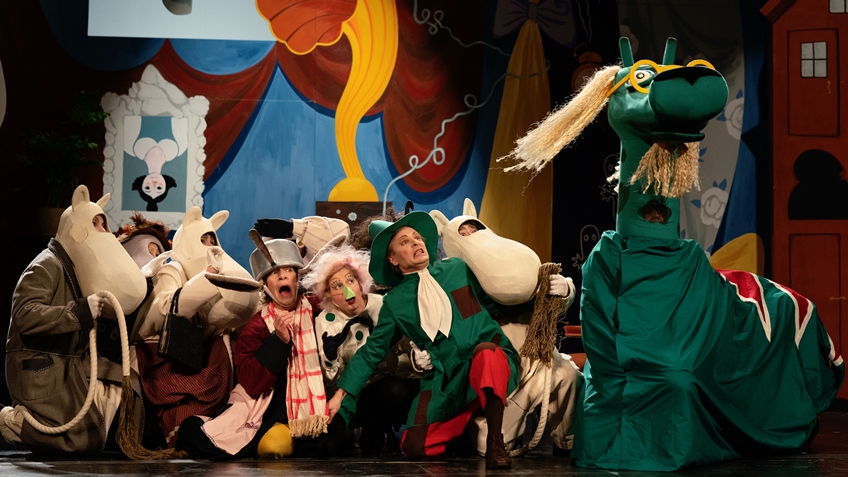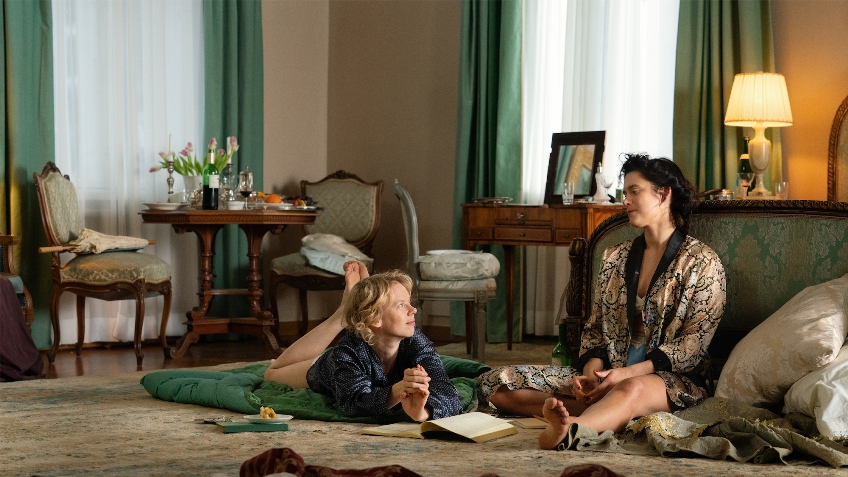Joyce Glasser reviews Tove (July 9, 2021) Cert 12A, 103 mins.
For Moomins’ fans, Finnish director Zaida Bergroth’s Tove, now showing in cinemas, will be worth the wait. The eponymous protagonist is, of course, Tove Jansson (Alma Pöysti), and the film is a biopic of a female author-illustrator, cartoonist and painter whose creatures are far better known than is their creator.
Bergroth, with her largely female crew, including scriptwriter Eeva Putro, production designer Catharina Nygvist Ehrnrooth, and cinematographer Linda Wassberg (maximising the benefits of 16mm film) immerse us in a little-known WWII (1944) and post WWII (1947 and 1952) Helsinki, Finland, to focus on Tove’s sexual awakening and to a lesser extent, key moments in her professional life.
The balance is a lot better than in the recent film Ammonite, where the English fossil hunter Mary Anning’s life was reduced to a fictitious lesbian love affair, leaving us no wiser as to why we should know about this remarkable woman.
Tove’s sexual identity is not made up as in Ammonite, and everything in the well- researched film rings true, beginning with a thrilling scene of Pöysti dancing with wild abandon in WWII before a bomb sends her running to the shelter, and ending with a shot of the real Tove dancing with joy in the sunshine. This prepares us for the free-spirited, free-thinking, spontaneous soul portrayed so brilliantly by Pöysti in the film.
Yet those who have yet to bond with the Moomin characters – those apparently endearing, androgenous, white, round trolls that resemble hippos – are not going to learn much about them, or their beginnings (long before 1944) or their evolution. For Tove, who was born in 1914, was already a published author at 14, and her first Moomin was drawn in an argument with one of her brothers (both of whom were artists, with Lars collaborating with her on the Moomins) to represent the philosopher Kant. How the creature evolved from the ugliest image she could come up with in youth, to the adorable creatures of the 1940s, is unexplored.
It is also said that the characters were inspired by her family, but we only meet Lars (Wilhelm Enckell), a talented artist, briefly and their father, Viktor (Robert Enckell), the ultra -conservative sculptor, berating his daughter for not winning grants like him because she is wasting her time on doddles. Yet it is impossible to imagine Tove without her mother, Signe Hammarsten-Jansson (Kajsa Ernst), an important Finnish illustrator who designed banknotes for the Bank of Finland and over 200 postage stamps. She taught Tove to draw before the child could walk and was a huge support in her career. Yet her character and influence are all but glossed over.

Soon after being berated by Viktor for her Moomin drawings, she moves into a war damaged flat with no electricity or running water, but large windows and, for a bedsit, generous proportions. Over time it is converted into a comfortable, welcoming and atmospheric artist’s studio, where Tove spends much of her adult life.
Although you’d never really know it from the film, Tove’s first three books were published between 1945 and 1948: The Moomins and the Great Flood, Comet in Moominland and Finn Family Moomintroll. In the film there is no acknowledgement of these milestones.
Nor do we learn much about Tove’s political work in the 1930s. At a party there is a quick reference to her famous cartoon of Hitler, as a screaming diapered baby, being placated with cake by European leaders, including Neville Chamberlain. The film only ever-so-lightly refers to Finland’s traumatic war, in which it battled the Soviet Union, that controlled Finland in 1939, then with the Soviet Union and Nazi Germany and then fighting against Nazi Germany – with the Allied forces.
We are, however, going to get intimately, if 12A discreetly, involved in Tove’s sexual life as she prevaricates between a passionate love for the confident Mayor’s daughter, Vivica Bandler (Krista Kosonen) and a left-wing MP Atos Wirtanen (Shanti Roney). Vivica, who is married, tells an astonished Tove that being married is “convenient”, for their kind, which might be why she strings Atos along. That said, her sudden request that he propose is done out of revenge for Vivica’s unfaithfulness.
Poor besotted Atos. He is seduced by Tove at a party; leaves his family for her and offers her a job writing a comic strip for Ny Tid, a left leaning publication with which he is affiliated. In real life she accepts, but the film leaves her thinking about it as though to avoid getting bogged down in work scenes. And then, after a wary Atos accepts Tove’s offer of marriage, he is dumped with a sincere apology. At this point Atos realises that her affair with Vivica is no experimental lark.

Vivica needs something to do as a wealthy, married lesbian in society circles, and has become a theatre impresario and director. The tall, stone-faced, calculating woman overpowers Tove: the physical (and visual) embodiment of the control she exerts on the artist. When Vivica has the idea to collaborate on a play based on Moomin characters, even Viktor has to be impressed with the applause from delighted children and parents as Vivica invites Tove on stage with her.
But the film audience cannot quite share in the celebration as the play would hardly convert anyone to Finn Family Moomintroll. Re-enactments of plays within films are notoriously difficult to get right (a major exception is Richard Linklater’s Me and Orson Welles), but this one looks like an amateur embarrassment.
Tove gradually realises she is a lesbian, but by the end of the film, when she meets her long term partner Tuulikki Pietilä (Joanna Haartti, another near lookalike casting choice), she has also realised that her infatuation for the predatory, serially unfaithful, troubled Vivica is self-destructive. The way is clear for a productive and loving relationship in which Tove paints and produces autobiographical books (Summer Book) and contemplates what kind of artist she wants to be.
Biopics that take the cradle to grave approach are seldom successful as they are spread too thin and cannot delve deep into what forms and drives the protagonists. Bergoth avoids that pitfall. But she has a challenge with a character like Tove. For all its merits, what we learn most about this remarkable woman and what we remember is her sexual awakening as a lesbian.
Joyce Glasser, Mature Times film critic.




